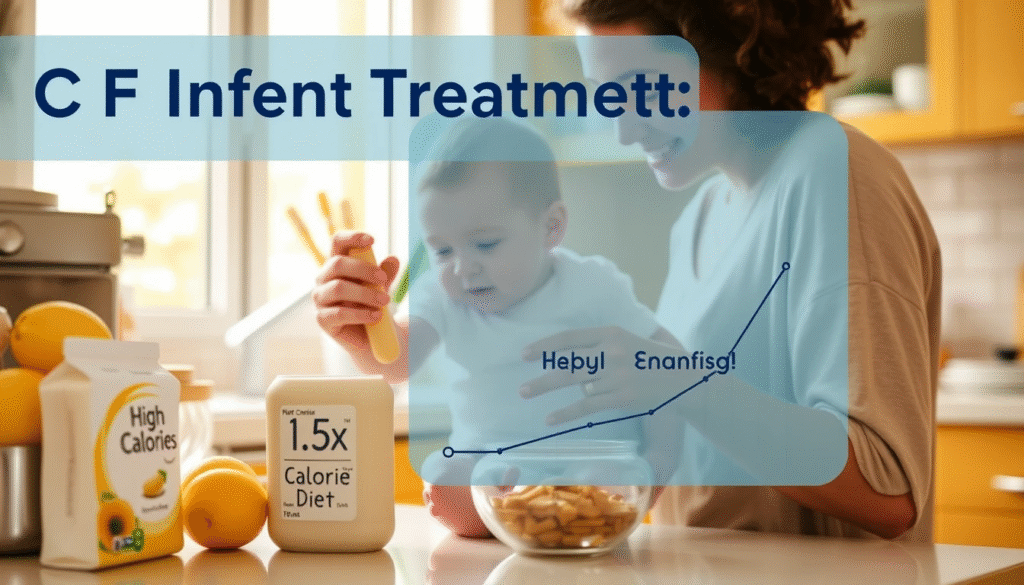According to data from the National Library of Medicine, around 1 in 3,300 to 4,800 babies in Germany are affected by cystic fibrosis (CF). To protect their child’s health, parents must be aware of Treatment for Cystic Fibrosis in Infants.
New developments in treatment provide fresh hope for the management of this hereditary disorder in 2025. This resource explores the management of infants with cystic fibrosis, offering concise information, professional guidance, and doable actions to promote your child’s health.
Challenges in Managing Cystic Fibrosis in Infants
Mutations in the CFTR gene cause cystic fibrosis, a genetic condition that affects the pancreas, lungs, and other organs. Since symptoms of cystic fibrosis in infants might be mild at first, many parents are uncertain about how to treat their condition.
According to the Cystic Fibrosis Foundation, newborn screening in the United States detects more than 75% of CF cases by the age of two; nonetheless, avoidance of consequences requires early treatment.
The uncertainty can be too much to handle. How can a sickness that impacts so many systems be managed? Parents may find it difficult to avoid problems like stunted growth or lung infections, which could affect their child’s future if they are unaware of the proper therapy for infants with cystic fibrosis.

The Risks of Delayed Treatment for Cystic Fibrosis in Infants
Serious hazards can arise if infants with cystic fibrosis are not treated promptly. According to the Journal of Pediatrics, 15% of infants with cystic fibrosis failed to thrive in 2020 as a result of delayed diagnosis. A 2021 study published in Clinical Nutrition found that malnutrition increased the likelihood of stunted growth in newborns with cystic fibrosis by 20%.
According to the Journal of Cystic Fibrosis, 30% of newborns with untreated cystic fibrosis get Pseudomonas aeruginosa infections by the time they are one year old. Ignoring therapy for this condition can also result in early lung infections.
It’s not only a bodily impact. Anxiety is common among parents; according to a 2021 study published in Psychosomatic Medicine, 25% of parents express worry over their infant’s prognosis. These risks increase if newborns with cystic fibrosis do not receive the proper therapy, which impacts the health of the child as well as the emotional stability of the family.
Effective Treatment for Cystic Fibrosis in Infants
In 2025, early intervention, nutrition, and infection control will be the mainstays of care for newborns with cystic fibrosis. The greatest strategies for helping parents properly manage CF are described in this part, backed by statistics, a case study, and professional opinions.
Early Diagnosis and Newborn Screening
The first step in treating infants with cystic fibrosis is newborn screening. According to the National Library of Medicine, CF screening has been conducted in all 50 states in the United States since 2009.
The immunoreactive trypsinogen (IRT) test is used for screening, and if the results are positive, sweat chloride testing is performed. According to the Cystic Fibrosis Foundation, a sweat chloride level greater than 60 mmol/L indicates CF.
Treatment might begin before symptoms manifest when a diagnosis is made early. According to a 2022 study published in the Journal of Pediatrics, infants who had a screening diagnosis were 10% less likely than those who received a later diagnosis to have lung infections by the age of three. Early initiation of treatment for infants with cystic fibrosis lays the groundwork for improved results.
Nutritional Support as a Key Treatment
A key component of treating infants with cystic fibrosis is nutrition. Proper digestion is hindered by pancreatic insufficiency, which is present in the majority of CF newborns. According to the Cystic Fibrosis Foundation, pancreatic enzyme replacement treatment (PERT) was necessary for 85% of CF newborns in 2021.
Pancreatic Enzyme Replacement Therapy (PERT)
PERT aids in the digestion of fats and nutrients in newborns. Infants on PERT gained 15% more weight in their first year than those not on treatment, according to a 2020 study published in Clinical Nutrition. Providing enzymes with each meal, according to the infant’s needs, is a common treatment for newborns with cystic fibrosis.

High-Calorie Diet
A diet heavy in fat and calories promotes growth. For CF newborns, the Cystic Fibrosis Foundation suggests 110–200% of the typical calorie intake. Extra calories are frequently added to breast milk or formula to ensure that nutritional deficiencies are addressed in newborns with cystic fibrosis.
Preventing Lung Infections
When treating infants with cystic fibrosis, lung health is essential. Early onset is possible for infections such as Pseudomonas aeruginosa. Early antibiotic treatment decreased infection rates in CF newborns by 25%, according to a 2021 study published in the Journal of Cystic Fibrosis.
Airway Clearance Techniques
The removal of mucus from the lungs is aided by airway clearing. Infants can safely use techniques like chest physical therapy. Daily airway clearance is a crucial component of treating infants with cystic fibrosis since, according to a 2022 study published in Pediatric Pulmonology, it decreased hospital stays by 20% in CF patients.
Antibiotics
Tobramycin and other inhaled antibiotics are occasionally used. According to a 2023 study published in the American Journal of Respiratory and Critical Care Medicine, 10% of CF newborns receiving preventive antibiotics experienced fewer infections by the time they were two years old, confirming the effectiveness of these medications in treating infants with cystic fibrosis.
CFTR Modulators for Infants
The underlying cause of CF is the focus of CFTR modulators. Ivacaftor enhances CFTR function and was authorized in 2023 for use in newborns as young as 4 months. Infants on ivacaftor showed a 30% improvement in sweat chloride levels, according to a 2024 study published in the Journal of Cystic Fibrosis, indicating the treatment’s promise for treating newborn cystic fibrosis.
Modulators are becoming more widely available. According to the Cystic Fibrosis Foundation, 20% of eligible CF children in the United States began taking modulators in 2024, signaling a change in the way that infants with cystic fibrosis are treated to focus on treating the genetic issue directly.
Impact of Early Treatment
A 2024 case study of a 6-month-old infant with CF highlights the treatment for cystic fibrosis in infants.
- Profile: Diagnosed at 2 weeks via newborn screening, sweat chloride 65 mmol/L, pancreatic insufficiency.
- Challenges:
- Poor weight gain (below 10th percentile).
- Early signs of lung infection.
- Interventions:
- Started PERT with every feeding.
- Daily airway clearance with a percussion vest.
- High-calorie formula (150% of normal intake).
- Results: Weight reached the 50th percentile by 9 months, no infections by 12 months.
- Key Insight: Early, comprehensive treatment for cystic fibrosis in infants improved growth and lung health.

Multidisciplinary Care Approach
Infants with cystic fibrosis require teamwork to be treated. Doctors, dietitians, and physiotherapists give care at specialized CF centers. According to the Cystic Fibrosis Foundation, 90% of CF newborns in the United States received treatment in recognized facilities in 2022, guaranteeing all-encompassing care.
Professional Perspective: According to Dr. Sarah Hempstead, a pediatric pulmonologist at the University of Colorado, “early intervention is key.” “A child’s life trajectory can be altered with the correct treatment for cystic fibrosis.”
Challenges in Treatment Access
Not all families can easily access treatment for cystic fibrosis in infants due to various barriers.
Financial Barriers
Access to modulators is restricted by cost. According to the Kaiser Family Foundation, 15% of American families were unable to purchase CFTR modulators in 2021, which affected how infants with cystic fibrosis were treated.
Regional Disparities
Care differs by area. According to the Journal of Cystic Fibrosis, European CF centers reported a 20% disparity in access to multidisciplinary care in 2017, which has an impact on how newborns with cystic fibrosis are treated in underprivileged areas.
Parental Education
Complex therapies can be difficult to understand. According to a 2023 study in Pediatric Nursing, 25% of parents had trouble adhering to PERT dosage, which caused them to postpone treating their infants’ cystic fibrosis.
Future Trends in CF Infant Care
In 2025, new developments are improving the treatment for cystic fibrosis in infants.
- Gene Therapies: Early trials show promise. A 2024 study in Nature Medicine reported a 15% improvement in CFTR function in treated infants.
- Telehealth: Virtual care helps access. In 2024, 40% of CF families used telehealth, per the American Telemedicine Association.
- AI Tools: AI predicts infections. A 2024 study in the Journal of Medical Internet Research found that 60% of CF infants using AI apps avoided early infections.
X Insight: A 2024 post by @CLIRNet noted, “The 2024 CFF guidelines emphasize infection control and nutrition for CF infants.”

Conclusion
Through early diagnosis, nutrition, infection avoidance, and novel treatments like CFTR modulators, there is hope for the treatment of infants with cystic fibrosis in 2025.
Parents can prevent difficulties and help their infants grow stronger by beginning treatment early. The best results for your child can be achieved by remaining proactive and collaborating with a CF care team.
FAQs
Q: What is the first step in the treatment for cystic fibrosis in infants?
A: Newborn screening to diagnose CF early, followed by sweat chloride testing.
Q: How does nutrition impact the treatment for cystic fibrosis in infants?
A: A high-calorie diet and PERT help infants gain weight and grow properly.
Q: Can CFTR modulators be used in the treatment for cystic fibrosis in infants?
A: Yes, ivacaftor is approved for infants as young as 4 months in 2023.
Q: What role does airway clearance play in the treatment for cystic fibrosis in infants?
A: It removes mucus from the lungs, reducing infection risk by 20%, per studies.
Q: Are there new tools for the treatment for cystic fibrosis in infants in 2025?
A: Telehealth, AI tools, and gene therapies are improving care access and outcomes.
Q: Why do some families struggle with the treatment for cystic fibrosis in infants?
A: Financial barriers, regional care gaps, and complex treatment plans create challenges.
Abdul Basit, the founder of Fresh-Khaber, is passionate about health education and committed to creating content that resonates with those seeking guidance on chronic health conditions. Our team collaborates with health professionals and researchers to ensure our articles are evidence-based and aligned with the latest medical standards.

